Lyons W.C. (ed.). Standard handbook of petroleum and natural gas engineering.2001- Volume 1
Подождите немного. Документ загружается.


Well Cementing
1225
There are basically two squeeze cementing techniques used: the high-pressure
squeeze operation and the low-pressure squeeze operation.
High-pressure squeeze cementing operations are utilized where the hydraulic
pressure is used to make new channels in the rock formations (by fracturing
the rock) and force the cement slurry into these channels.
Low-pressure squeeze cementing operations are utilized where the existing
permeability structure is sufficient to allow the cement slurry to efficiently move
in formation without making new fracture surfaces with the hydraulic pressure.
Hesitation method of applying pressure is applicable to both high and low-
pressure squeeze cementing operations. This method of applying pressure (and
thus volume) appears to be more effective than continuous pressure application.
The hesitation method is the intermittent application of pressure, separated by
a period of pressure leakoff caused by the loss of filtrate into the formation.
The leakoff periods are short at the beginning of an operation but get longer
as the operation progresses.
Figure
4-400
shows a typical squeeze cementing downhole schematic where a
retrievable packer is used. The cement slurry is spotted adjacent to the per-
forations in the casing. The packer raise and set against the casing wall. Pressure
is then applied to the drilling mud and cement slurry below the packer forcing
the cement slurry into the perforations and into the rock formation or voids in
the annulus behind the casing.
Figure
4-401
shows how a retrievable packer with a tail pipe can be used to
precisely spot the cement slurry at the location of the perforations.
Figure
4-402
shows how a drillable cement retainer can be used to ensure
that the cement slurry will be applied directly to the perforations.
Most squeeze cementing operations take place in cased sections of a well.
However, open-hole packers can be used to carry out squeeze cement operations
of thief zones during drilling operations.
Another technique for carrying out a squeeze cementing operation is the
Bradenhead technique. This technique can be used to squeeze a cement slurry
30-
-
100
FT
1
I
I
Figure
4-400.
Retrievable packer near perforations
[161].

1226
Drilling and Well Completions
RUNNING
TAIL
PIPE SPOTTING CEMENT SOUEUING
ALL
PERH)RATIONS
TO
BELOW
THE
PERFORATIONS PACKER
ABOVE THE
CEMENT
AFTER SETTING
TAIL
PIPE
AND
I
Figure
4-401.
Retrievable packer with tail pipe
[161].
Figure
4-402.
Drillable cement retainer
[161].
in
a
cased hole
or
in an open hole. Figure
4-403
shows a schematic of the
technique. Instead of using a downhole packer, the cement slurry is spotted by
drillpipe
(or
tubing) adjacent to the perforations
or
a thief zone. After the
drillpipe has been raised, the pipe rams are closed over the drillpipe and pump
pressure applied to the drilling mud which in turn forces the cement slurry into
the perforations
or
fractures.
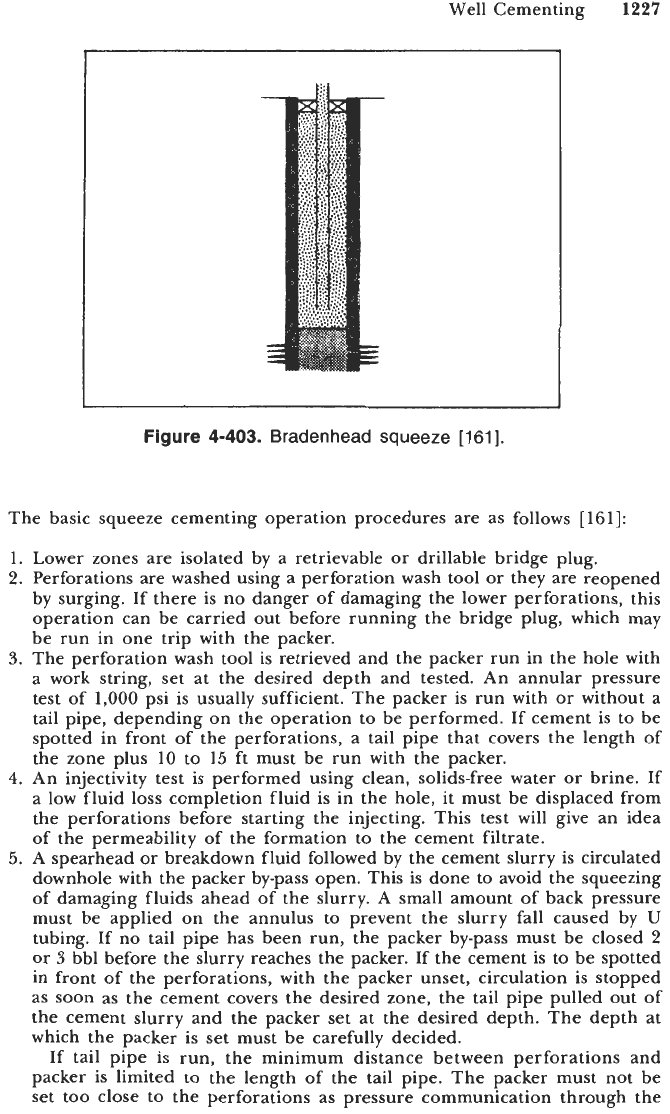
Well Cementing
1227
I
Figure
4-403.
Bradenhead squeeze
[161].
The basic squeeze cementing operation procedures are as follows
[161]:
1.
Lower zones are isolated by a retrievable
or
drillable bridge plug.
2.
Perforations are washed using a perforation wash tool
or
they are reopened
by surging. If there is no danger of damaging the lower perforations, this
operation can be carried out before running the bridge plug, which may
be run in one trip with the packer.
3.
The perforation wash tool is retrieved and the packer run in the hole with
a work string, set at the desired depth and tested. An annular pressure
test of
1,000
psi is usually sufficient. The packer is run with or without a
tail pipe, depending on the operation to be performed. If cement is to be
spotted in front of the perforations, a tail pipe that covers the length of
the zone plus
10
to
15
ft must be run with the packer.
4.
An injectivity test is performed using clean, solids-free water or brine. If
a low fluid loss completion fluid is in the hole, it must be displaced from
the perforations before starting the injecting. This test will give an idea
of the permeability of the formation to the cement filtrate.
5.
A spearhead
or
breakdown fluid followed by the cement slurry is circulated
downhole with the packer by-pass open. This is done to avoid the squeezing
of damaging fluids ahead of the slurry.
A
small amount of back pressure
must be applied on the annulus to prevent the slurry fall caused by
U
tubing. If no tail pipe has been run, the packer by-pass must be closed
2
or
3
bbl before the slurry reaches the packer. If the cement is to be spotted
in front of the perforations, with the packer unset, circulation is stopped
as soon as the cement covers the desired zone, the tail pipe pulled out of
the cement slurry and the packer set at the desired depth. The depth at
which the packer is set must be carefully decided.
If tail pipe is run, the minimum distance between perforations and
packer is limited to the length of the tail pipe. The packer must not be
set too close
to
the perforations as pressure communication through the
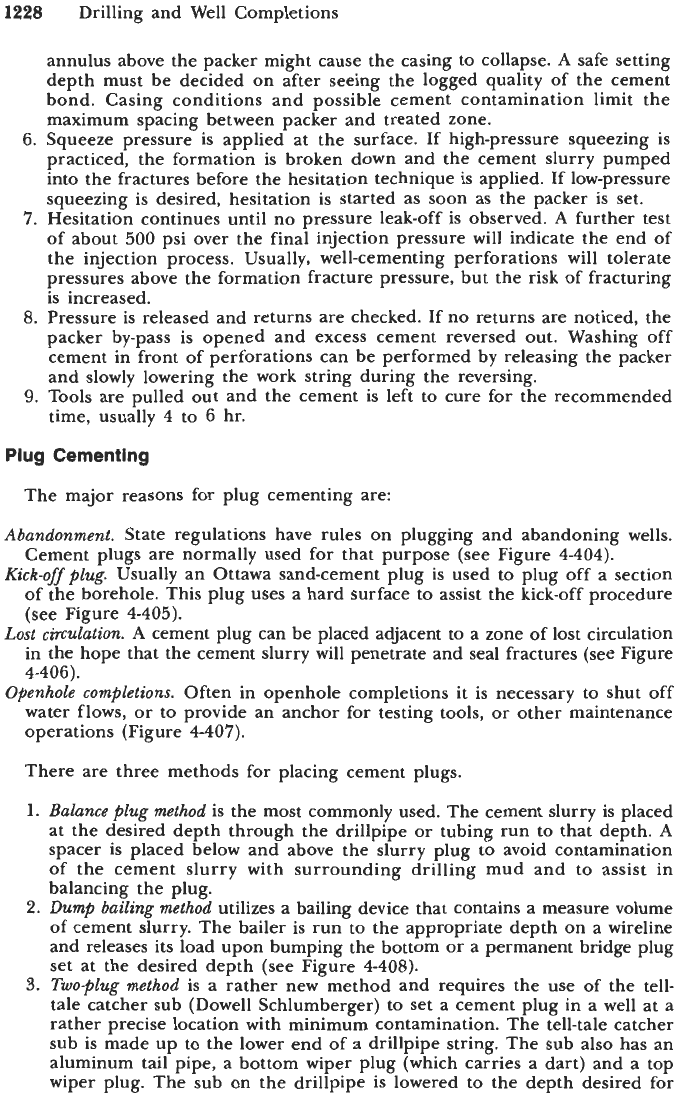
1228
Drilling and Well Completions
annulus above the packer might cause the casing to collapse.
A
safe setting
depth must be decided on after seeing the logged quality of the cement
bond. Casing conditions and possible cement contamination limit the
maximum spacing between packer and treated zone.
Squeeze pressure is applied at the surface. If high-pressure squeezing is
practiced, the formation is broken down and the cement slurry pumped
into the fractures before the hesitation technique is applied. If low-pressure
squeezing is desired, hesitation is started as soon as the packer is set.
Hesitation continues until no pressure leak-off
is
observed.
A
further test
of about
500
psi over the final injection pressure will indicate the end of
the injection process. Usually, well-cementing perforations will tolerate
pressures above the formation fracture pressure, but the risk of fracturing
is increased.
Pressure is released and returns are checked. If no returns are noticed, the
packer by-pass is opened and excess cement reversed out. Washing off
cement in front of perforations can be performed by releasing the packer
and slowly lowering the work string during the reversing.
Tools are pulled out and the cement is left to cure for the recommended
time, usually
4
to
6
hr.
Plug
Cementing
The major reasons for plug cementing are:
Abandonment.
State regulations have rules on plugging and abandoning wells.
Cement plugs are normally used for that purpose (see Figure
4-404).
Kick-off
plug.
Usually an Ottawa sand-cement plug is used to plug off a section
of the borehole. This plug uses a hard surface to assist the kick-off procedure
(see Figure
4-405).
Lost circulation.
A
cement plug can be placed adjacent to a zone of lost circulation
in the hope that the cement slurry will penetrate and seal fractures (see Figure
Openhole completions.
Often in openhole completions it is necessary to shut off
water flows,
or
to provide an anchor for testing tools, or other maintenance
operations (Figure
4-407).
There are three methods for placing cement plugs.
1.
Balance plug method
is the most commonly used. The cement slurry is placed
at the desired depth through the drillpipe or tubing run to that depth.
A
spacer is placed below and above the slurry plug to avoid contamination
of the cement slurry with surrounding drilling mud and to assist in
balancing the plug.
2.
Dump bailing method
utilizes a bailing device that contains a measure volume
of cement slurry. The bailer is run to the appropriate depth on a wireline
and releases its load upon bumping the bottom or a permanent bridge plug
set at the desired depth (see Figure
4-408).
3.
Two-plug method
is a rather new method and requires the use of the tell-
tale catcher sub (Dowell Schlumberger) to set a cement plug in a well at a
rather precise location with minimum contamination. The tell-tale catcher
sub is made up to the lower end of a drillpipe string. The sub also has an
aluminum tail pipe, a bottom wiper plug (which carries a dart) and a top
wiper plug. The sub on the drillpipe is lowered to the depth desired for
4-406).
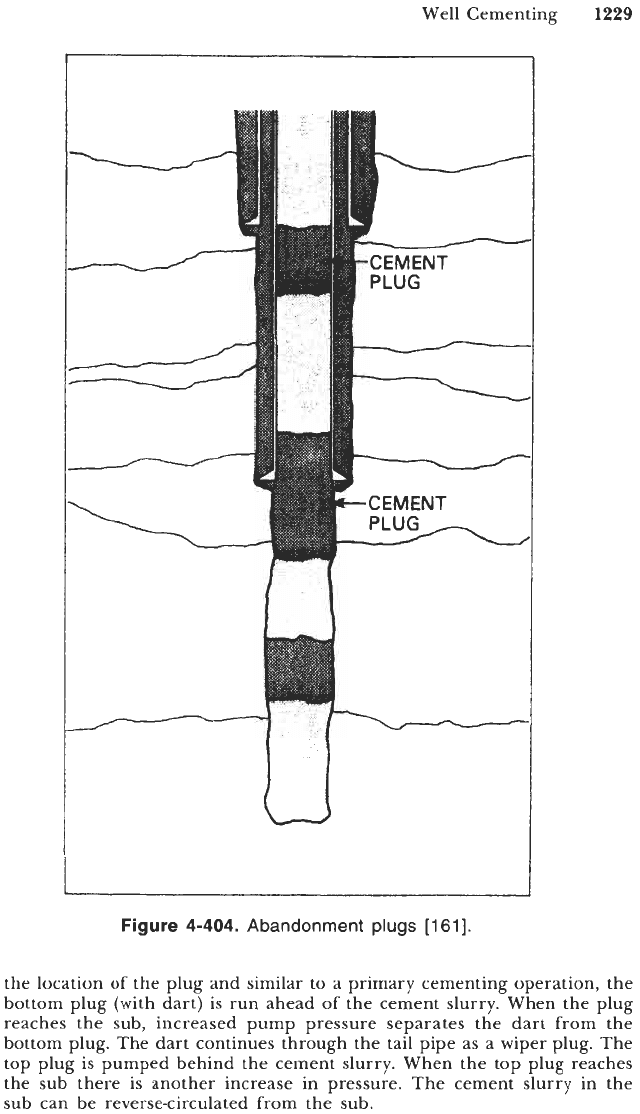
Well Cementing
1229
-
D
-CEMENT
Figure
4-404.
Abandonment
plugs
[161].
the location of the plug and similar to a primary cementing operation, the
bottom plug (with dart) is run ahead
of
the cement slurry. When the plug
reaches the sub, increased pump pressure separates the dart from the
bottom plug. The dart continues through the tail pipe as a wiper plug. The
top plug is pumped behind the cement slurry. When the top plug reaches
the sub there is another increase in pressure. The cement slurry in the
sub can be reverse-circulated from the sub.
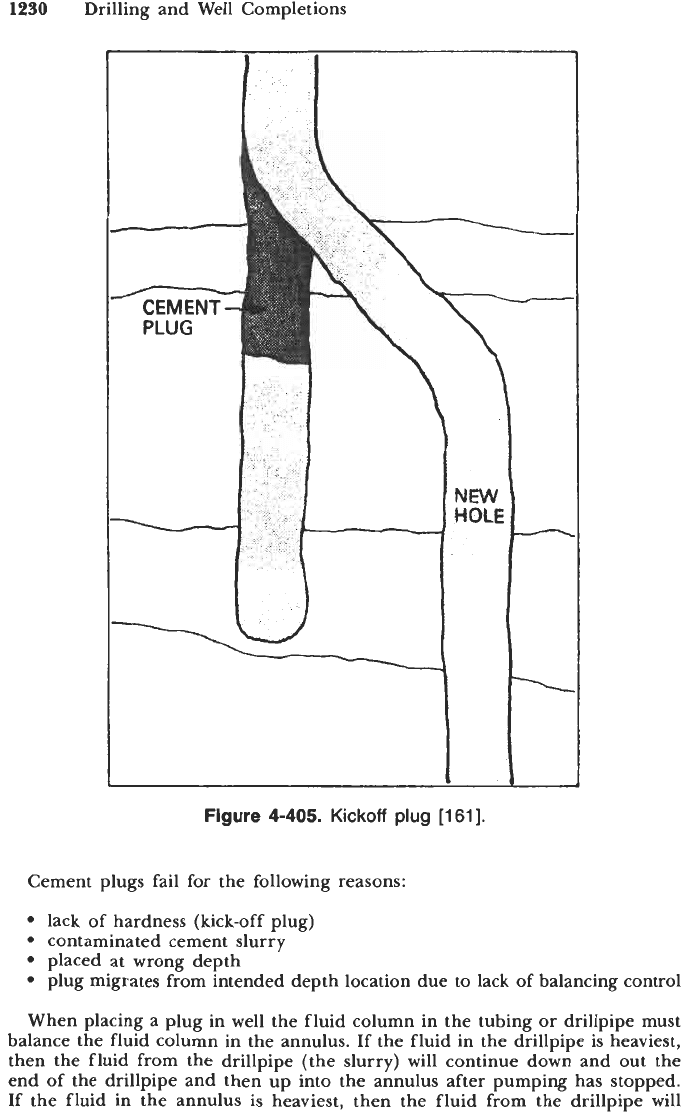
1430
Drilling and Well Completions
Figure
4-405.
Kickoff
plug
[161].
Cement plugs fail for the following reasons:
lack of hardness (kick-off plug)
contaminated cement slurry
placed at wrong depth
plug migrates from intended depth location due to lack of balancing control
When placing a plug in well the fluid column in the tubing
or
drillpipe must
balance the fluid column in the annulus. If the fluid in the drillpipe is heaviest,
then the fluid from the drillpipe (the slurry) will continue down and out the
end of the drillpipe and then up into the annulus after pumping has stopped.
If the fluid in the annulus is heaviest, then the fluid from the drillpipe will
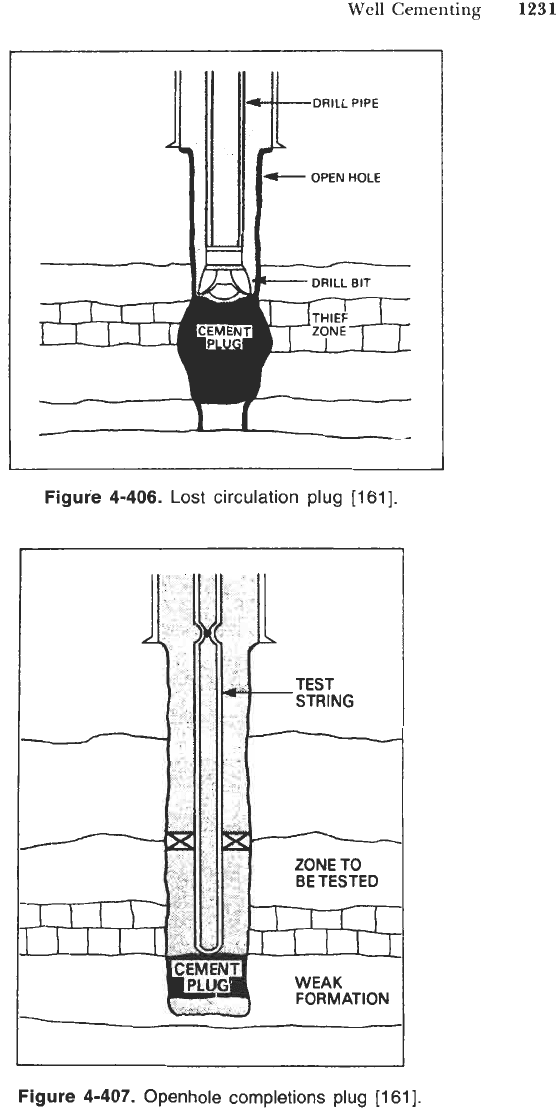
Well Cementing
1231
1
Figuie
4-406.
Lost
circulation plug
[161].
I
Figure
4-407.
Openhole completions plug
[161].
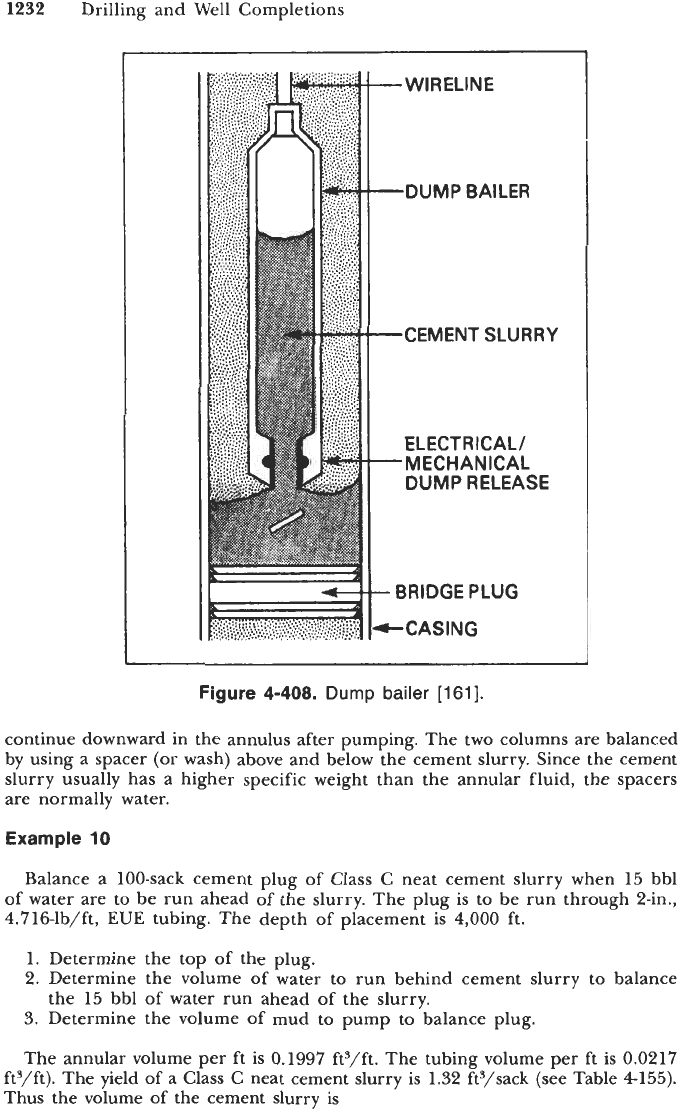
1232
Drilling and Well Completions
DUMP BAILER
CEMENT SLURRY
MECHANICAL
DUMP RELEASE
BRIDGE PLUG
Figure
4-408.
Dump
bailer
[161].
continue downward in the annulus after pumping. The two columns are balanced
by using a spacer
(or
wash) above and below the cement slurry. Since the cement
slurry usually has a higher specific weight than the annular fluid, the spacers
are normally water.
Example
10
Balance a 100-sack cement plug of Class C neat cement slurry when 15 bbl
of water are to be run ahead of the slurry. The plug
is
to be run through 2-in.,
4.716-lb/ft,
EUE
tubing. The depth of placement is
4,000
ft.
1. Determine the top of the plug.
2.
Determine the volume of water to run behind cement slurry to balance
3.
Determine the volume of mud to pump to balance plug.
The annular volume per ft is 0.1997 ft3/ft. The tubing volume per ft is 0.0217
ft3/ft). The yield of a Class C neat cement slurry is 1.32 ft3/sack (see Table 4155).
Thus the volume of the cement slurry is
the 15 bbl of water run ahead of the slurry.
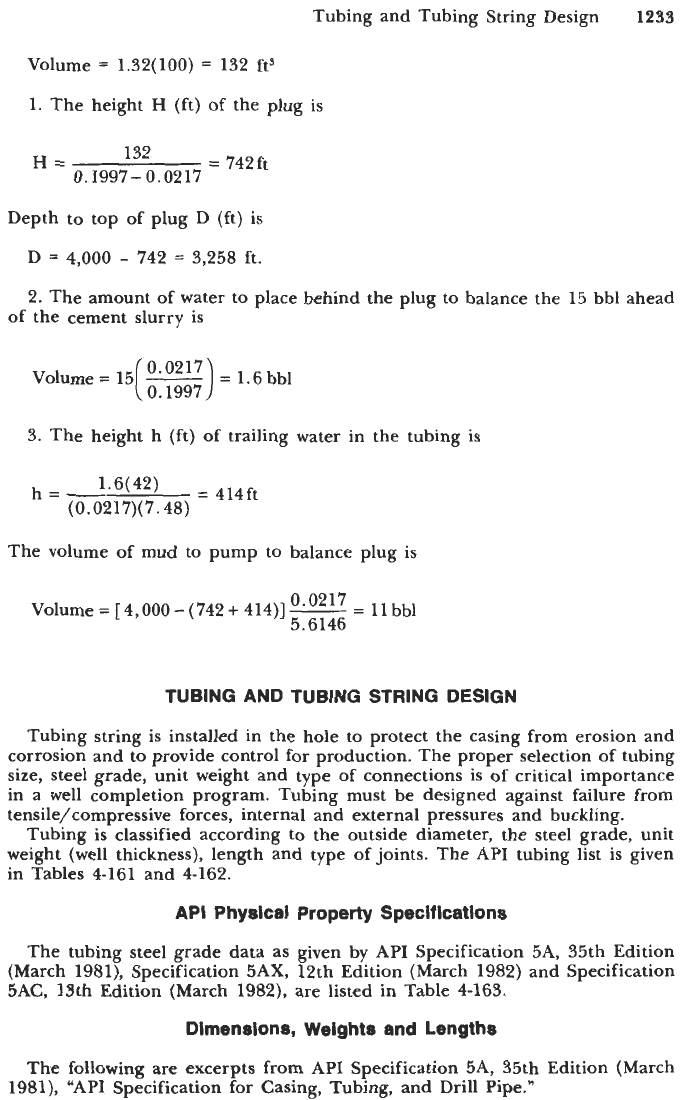
Tubing and Tubing String Design
1233
Volume
=
1.32(100)
=
132 ft’
1. The height
H
(ft)
of the plug is
=
742ft
132
H=
0.1997-0.0217
Depth to top of plug
D
(ft)
is
D
=
4,000
-
742
=
3,258 ft.
2.
The amount of water to place behind the plug to balance the 15 bbl ahead
of
the cement slurry is
3. The height h (ft) of trailing water in the tubing is
The volume of mud to pump to balance plug is
0
0217
5.6146
Volume
=
[
4,000
-
(742
+
414)]
-
=
11 bbl
TUBING AND TUBING STRING DESIGN
Tubing string is installed in the hole to protect the casing from erosion and
corrosion and to provide control for production. The proper selection of tubing
size, steel grade, unit weight and type of connections is of critical importance
in a well completion program. Tubing must be designed against failure from
tensile/compressive forces, internal and external pressures and buckling.
Tubing is classified according to the outside diameter, the steel grade, unit
weight (well thickness), length and type of joints. The API tubing list is given
in Tables 4-161 and 4-162.
API Physlcal Property Specifications
The tubing steel grade data as given by API Specification 5A, 35th Edition
(March 1981), Specification 5AX, 12th Edition (March 1982) and Specification
5AC,
13th Edition (March
1982),
are
listed in Table 4-163.
Dlmenslons, Weights and Lengths
The
following are excerpts from API Specification 5A, 35th Edition (March
1981), “API Specification for Casing, Tubing, and Drill Pipe.”
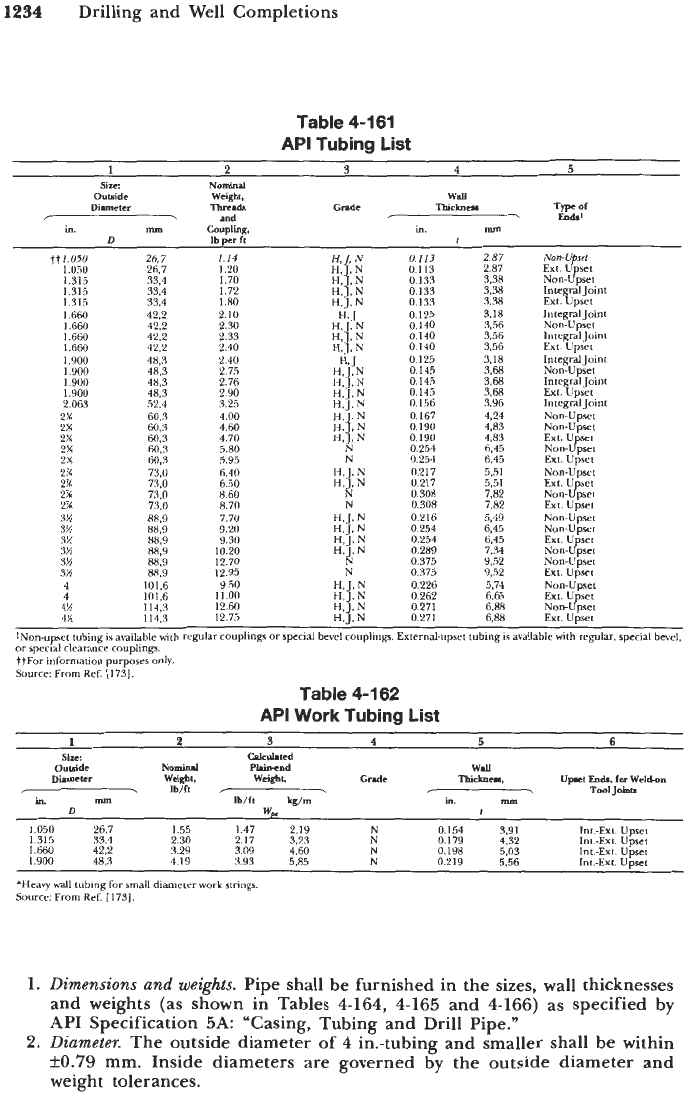
1234
Drilling and Well Completions
Table 4-161
API
Tubing List
1
2
3
4
5
Size:
NOminll
Outside
Weqht.
Wall
in.
mm
coupling,
in.
Mn
D
Ib
pr
fl
t
Dinmeter k.dr
Grade
llliclrna
Type
of
r
md
Eodd
tt1.050
1.050
1.315
1.315
1.315
1
6W
1.660
1.660
1.660
1.900
1
900
1900
1.900
2.063
2%
2%
2%
2%
2%
2u
21
2Y
22'
26.7
26.7
33.4
33,4
33.4
422
42.2
42.2
42.2
48.3
48,3
48,3
48,3
52.4
60.3
60,s
60.3
W,3
73,O
73,O
73.0
73.0
88.9
88,9
88,9
88.9
60,s
n8,y
88.9
101.6
101.6
114.3
114.3
1.14
1.20
1.70
1.72
1.80
2.10
2.30
2.33
2.40
2
40
2
75
2.76
2.90
3.25
4.00
4.60
4.70
5.80
5.95
6.50
8.60
x.70
6.40
7.70
9.20
y.30
10.20
12.70
12.95
9.50
11.00
12.W
12.75
H,J,N
0.113
2.87
Nm-Up~et
0.113 2.87
Ext. Upset
3,38
Non-Upset
33
Integral Joint
H.J. N
0.133
3.38 Ext. Upset
0.125
3.18
IntegralJoint
3.56
Non-Upset
0.140
N
0.140 3,56
Integral Joint
H,.
,
N
0.140
3,56
Ext Upset
0
125 3,18
Integral Joint
3.68
Non-Upset
3.68
Integral Joint
H.J.
H'J
N
0.145
H.J. N
0.145
H.J.
N
0.145
3.68
Ext.
Upset
H,J,
N
0.156
3,96
Integral Joint
0.167 4,24
Nan-Upset
0.190 433
Non-Upset
H.
J,
N
0.190
4,83
Ext. Upset
""N
N
0.254
6.45
Non-Upset
N
0.254
6.45
Ext. Upset
H,J,N
0.217
5.51
Non-Upset
H.J.
N
0
217
5.51
Ext.
U
set
N
0.308 732
Non-&set
N
0.308
7,82
Ex[. Upset
H.J.N
0.216
5,49
Nan-Upset
H.J. N
0.254
6,45
Nun-Upset
0.254
6,45
Exr. Upset
0.289
7.34
Non-Upset
0.375
9.52
Non-Upset
N
0.375
9.52
Ext.
U~w1
3%
3%
3%
3%
3%
3%
4%
H,J,N
0271
6.88
Non-&set
4%
H,J.N
0.271
638
Ext. Upset
4
H,J,
N
0.226 5,74
Non-Upset
4
H,J, N
0.262
6.65
Ext. U set
INm-upset tubing
1s
available with
regular
couplings
or
special
bevel couplings. External-upart tubing is available with
regular,
special
bevel,
or
special clearance couplings.
ttFor
information purposes
only.
Source:
From
Ref.
[
1731.
Table 4-162
API
Work
Tubing List
1
2
3
4
5
6
Sk:
CnCNJlted
Outdde
NO&
Plainend
Wd
in.
Mn
Ib/ft
k/m
in.
mm
DinmehI
weight,
WeigilL
Grade
Tbidmnr,
Upaet
Enda,
for
Weld+"
,
Ib/fl
r
r
,
Tml
Joinm
N
1.050 26,7
1.55
1.47
2.19
0.154 3.91
1315
33.4 2.30 2.17
3.23
0.179 4.32
Int-Ext. Upset
N Int.-Ext. Upset
1.W
422
3.29
3.09
4,60
N
0.1Y8
5.03
1nt:Ext. Upser
1.900
40.3
4.19
3.93
5.85
N
0.219
5.56
Int.-Exl.
U~set
*Hay
wall
tubing
for
small
diameter
WOI
k
strings.
Source:
From
Ref.
[173].
1.
Dimensions and weights.
Pipe shall be furnished in the sizes, wall thicknesses
and weights (as shown in Tables
4-164, 4-165
and
4-166)
as
specified by
API Specification
5A:
"Casing, Tubing and Drill Pipe."
2.
Diameter.
The outside diameter of
4
in.-tubing and smaller shall be within
k0.79
mm. Inside diameters are governed by the outside diameter and
weight tolerances.
